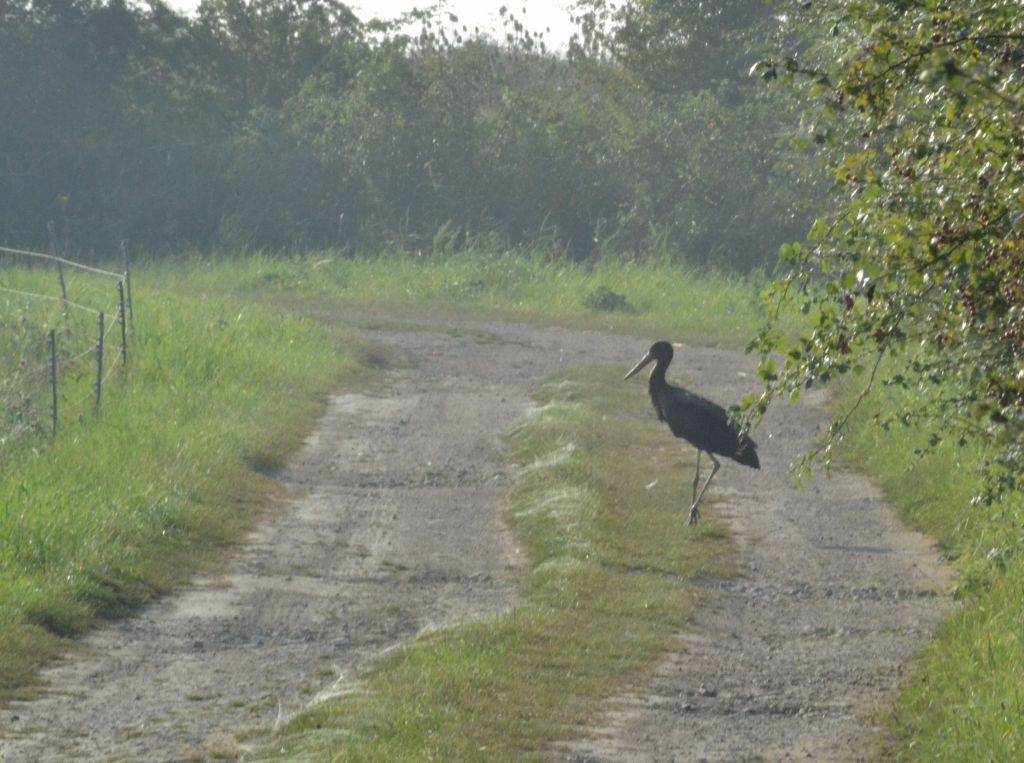After three recent bird lifers – Pacific Golden Plover, Black-browed Albatross and White-tailed Lapwing – I have now completed what I regard as the “regional set” for Lincolnshire and East Yorkshire for this late summer. A long staying juvenile Black Stork in the first of those counties has been bugging me for some time.
This long-legged bird visited RSPB Frampton Marsh briefly while I was connecting with the PGP’s on 14th August (see here). Then I spent four hours searching for it on 22nd at nearby RSPB Freiston Shore, a day on which it went temporarily AWOL. But in between and since those dates it has been reported regularly from one reserve or the other. So on not sleeping past 4am this morning I upped and went to try to get the job done properly.
This was forecast to be a very hot “Indian summer” day, and what a contrast to my previous attempt it produced! Arriving on site at 8:45am I opted to first check out the location of my quest’s last report on RBA the previous evening. That was a field just to the north of Frampton Marsh with a grid reference TF355398. Parking at the top of an access track into it, I set out to scan Wyberton Marsh towards the sea and what should be standing there right ahead of me and directly into the sun (pictured below) but the Black Stork of my intent.
The initial connect today was as simple as that. There was already a significant heat haze that combined with glare throughout the morning to come rendered all the images in this post no more than “record shots” that show I am not making all this up. For the RBA gallery of this bird, which has wandered East Yorks and more especially Lincs since 7th August see here.
I will admit to then putting the bird up, since I was not as careful in my approach than if other observers had been present. But whether people might have been watching from afar and so witnessed my misdemeanour I didn’t know. So moving on to RSPB Frampton Marsh (PE20 1AY – TF357390) I kept quiet. But I was soon exonerated as the Black Stork flew in, making a low aerial pass in front of the visitor centre before settling in the middle distance.
Hence every birder in the vicinity enjoyed very good views. When the Stork next took flight it circled overhead before heading back towards where I had first stumbled upon it. The idea formed in my mind of sneaking back out there away from the crowds, but I hung around a while longer. And when a birder walking back from that direction said: “It was on the farm track just near me in that field where the sheep are 15 minutes ago,” things sounded familiar.
Continuing along the visitor trail I noticed an open gate through the reserve boundary. Then checking out the farm track beyond it I realised I was back where my visit here had begun, but at first there was no sign of what I sought. Then the Black Stork flew in again (pictured below) to settle on the track away to the right, before relocating on my left at 300 metres.
Maybe this had become a favoured location for the wanderer. Now I took much more care over not spooking it and began to attempt pictures keeping in semi-cover, but I soon had company. As visitors walking the trail noticed the open gate, more and more came and went as numbers reached double figures at times over the next hour and a bit. For all that time the Stork just stood unconcerned in the same spot, panting in the heat and occasionally preening.
Having by this stage attempted endless unsatisfactory images I actually hoped someone might flush the bird so I could get flight studies, but it fell to the grazing sheep to eventually do the deed. Thus irritated the Black Stork at length took off again, circling ever higher before flying off north, and my own submission at that point was the last on RBA today.
I had observed Black Storks previously in Holland (Aug 1988), Greece (Apr 2017) and Turkey (June 2019). The species breeds in forested regions and marshy wetlands of east and south-eastern Europe and western Asia, wintering in tropical Africa, India and south-east Asia. Today, after those recent frustrations, this much chased British list addition (369) served extra helpings over and again on my third attempt for it, and is now well and truly dealt with.





